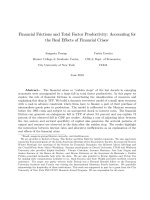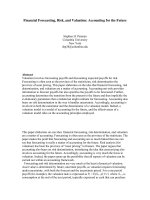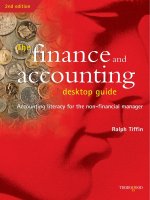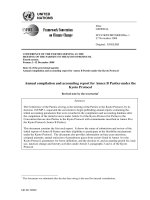Keeping the books basic recordkeeping and accounting for the successful small business
Bạn đang xem bản rút gọn của tài liệu. Xem và tải ngay bản đầy đủ của tài liệu tại đây (5.3 MB, 225 trang )
Seventh Edition
This publication is designed to provide accurate and authoritative information in regard to the subject matter
covered. It is sold with the understanding that the publisher is not engaged in rendering legal, accounting, or
other professional service. If legal advice or other expert assistance is required, the services of a competent professional person should be sought.
Editorial Director: Jennifer Farthing
Senior Managing Editor, Production: Jack Kiburz
Production Artist: Janet Schroeder
Cover Designer: Design Solutions
© 1989, 1993, 1996, and 1998 by Linda Pinson and Jerry Jinnett. © 2001, 2004, and 2007 by Linda Pinson
Published by Kaplan Publishing,
a division of Kaplan, Inc.
All rights reserved. The text of this publication, or any part thereof, may not be reproduced in any manner whatsoever without written permission from the publisher.
Printed in the United States of America
07 08 09
10 9 8 7 6 5 4 3 2 1
Published by Dearborn Trade Publishing
A Kaplan Professional Company
All rights reserved. The text of this publication, or any part thereof, may not be reproduced in any manner whatsoever without written permission from the publisher.
Printed in the United States of America
04 05 06 10 9 8 7 6 5 4 3 2 1
Library of Congress Cataloging-in-Publication Data
Pinson, Linda.
Keeping the books: basic recordkeeping and accounting for the successful small business /
Linda Pinson.—7th ed.
p. cm.
Previously published: Chicago, Ill.: Dearborn Trade Pub., ©2004
Includes bibliographical reference and index.
ISBN-13: 978-1-4195-8438-1 (alk. paper)
ISBN10: 1-4195-8438-3 (alk. paper)
1. Bookkeeping. 2. Small business—United States—Accounting. I. Title.
HF5635.P649 2007
657'.2—dc22
2006036384
Kaplan Publishing books are available at special quantity discounts to use for sales promotions, employee premiums, or educational purposes. Please call our Special Sales Department to order or for more information at
800-621-9621, ext. 4444, e-mail , or write to Kaplan Publishing, 30 South Wacker
Drive, Suite 2500, Chicago, IL 60606-7481.
Dedication
It is with a great deal of pleasure that I dedicate this book to Virginia Haverty, a wonderful friend who is
now gone, but never forgotten. Her gifts of encouragement and confidence live on in this book and in
my life.
iii
Other books and software by the author
Automate Your Business Plan software
Anatomy of a Business Plan
Steps to Small Business Start-Up
Contents
Preface——ix
Acknowledgments——xi
About the Author——xii
CHAPTER
1
Recordkeeping Basics . . . . . . . . . . . . . . . . . . . . . . . . . . . . . . . 1
Functions of Recordkeeping——1
When Does Recordkeeping Begin?——3
CHAPTER
2
Income and Expenses . . . . . . . . . . . . . . . . . . . . . . . . . . . . . . . 5
Income (or Revenue)——5
Expenses——5
What Are “Deductible” Expenses?——6
Common Deductible Expenses——7
CHAPTER
3
Cash Accounting versus Accrual Accounting . . . . . . . . . . . . . 9
“Cash” and “Accrual” Accounting Defined——9
Which Method Will You Be Required to Use?——10
Pros and Cons of the Two Methods——11
Can You Change Methods from Year to Year?——12
CHAPTER
4
Essential General Records for Small Business. . . . . . . . . . . . 13
Single and Double Entry Systems——14
Chart of Accounts——16
Debits and Credits——18
v
vi · Contents
An Overview of Four Accounting Tasks
Using QuickBooks Pro®——20
Summary: Accounting Software——24
Revenue & Expense Journal——26
Petty Cash Record——30
Inventory Record——32
Fixed Assets Log——38
Accounts Receivable——40
Accounts Payable——42
Payroll Records——44
Independent Contractors——47
Travel, Transportation,
and Entertainment Expenses——50
Customer Information Records——56
Business Checkbook——58
Receipt Files——60
CHAPTER
5
Financial Statements . . . . . . . . . . . . . . . . . . . . . . . . . . . . . . . 61
What Are Financial Statements?——61
Balance Sheet——63
Profit & Loss Statement or Income Statement——66
Business Financial History——70
Personal Financial Statement——74
Pro Forma Cash Flow Statement——76
Preparing Your Cash Flow Statement——77
Completing Your Pro Forma Cash Flow Statement——84
Quarterly Budget Analysis——86
Three-Year Income Projection——88
Breakeven Analysis——90
CHAPTER
6
Financial Statement Analysis . . . . . . . . . . . . . . . . . . . . . . . . 93
Financial Statements——93
Liquidity Analysis——96
Profitability Analysis——98
Debt Measures——100
Investment Measures——101
Vertical Financial Statement Analysis——102
Horizontal Financial Statement Analysis——104
Summary——105
CHAPTER
7
Taxes and Accounting . . . . . . . . . . . . . . . . . . . . . . . . . . . . . 107
Accounting and the U.S. Tax System——107
Federal Taxes for Which You May Be Liable——109
Income Tax (for Sole Proprietors)——114
Home Office Deduction——117
Income Tax (Partnerships)——119
Income Tax (S Corporations)——122
Income Tax (Corporations)——124
Contents · vii
Estimated Tax (for Sole Proprietor, Individual Who Is a Partner, or
an S Corporation Shareholder)——127
Estimated Tax (Corporations)——130
Self-Employment Tax (for Sole Proprietor, Individual Who Is a
Partner, or an S Corporation Shareholder)——132
Social Security (FICA) Tax and Withholding of Income Tax——135
Federal Unemployment (FUTA) Tax——142
Payment to Nonemployees for Services Rendered——145
Taxpayer Identification Number (EIN)——148
Free Tax Publications Available from the IRS——149
Summary——152
CHAPTER
8
Recordkeeping and Tax Reporting Schedules . . . . . . . . . . . 153
Organizing Your Recordkeeping——154
Building Your System——154
Recordkeeping Schedule——156
Tax Reporting Schedule——158
CHAPTER
9
Preparing for Uncle Sam. . . . . . . . . . . . . . . . . . . . . . . . . . . 161
What to Give Your Accountant——162
The Last Chore——163
APPENDIX
I
Independent Contractors: Facts versus Myths . . . . . . . . . . 165
APPENDIX
II
Blank Forms and Worksheets . . . . . . . . . . . . . . . . . . . . . . . 173
Small Business Resources——197
Glossary——199
Index——207
Preface
T
hank you for choosing Keeping the Books to use as your guide for learning about recordkeeping and small business accounting. I think you will be pleased with this new edition.
It has been the goal of each edition of this book to give you a clear, concise, and easy-tounderstand process to follow as you set up your bookkeeping and work with it throughout
the life of your business. I have been working with business owners for many years, and
most of them have the same problem—they are experts in their industries but are novices
when it comes to working with financials. In fact, many times, the prospect of keeping financial information is so formidable that some business owners avoid it until tax time when they
have to come up with the information for the IRS.
Keeping the Books should provide you with a clear, concise, and easy-to-understand process
for setting up, understanding, and attending to recordkeeping and accounting. If I have been
successful, you should be able to follow that process, customize it for your business, and set
up a system that will greatly benefit your company.
WHO IS THIS BOOK FOR?
I frequently am asked who Keeping the Books is appropriate for. This book is for all business
owners who need to better familiarize themselves with recordkeeping and accounting
processes and how these relate to tax accounting—even those business owners who hire inhouse bookkeepers and accountants and/or outside accounting professionals. Keeping the
ix
x · Preface
Books is not meant to take the place of accounting software, but should be utilized as a reference guide that will help you better understand and utilize general records and financial
statements.
The purpose of accounting is not just to provide the IRS with information at tax time. Its
main benefit is to boost your company’s profitability through periodic financial statement
analysis. If you do not understand how to read and utilize profit & loss statements and balance sheets, you are forfeiting one of the most valuable tools at your disposal.
Thank you again for choosing Keeping the Books to help you accomplish your financial
goals. I appreciate your confidence that it will help you, and wish you success in the operation of your businesses.
— Linda Pinson
Acknowledgments
D
uring the writing and revising of six editions of Keeping the Books, it has been my
good fortune (and the readers’) to have input from many business associates whose expertise
in certain areas admittedly exceeds my own. I would like to acknowledge three of those individuals here:
Judee Slack, owner of Slack Tax, Inc., in Fountain Valley, California (www.slacktax.com)
has been instrumental in keeping me on track through almost 20 years of changes in accounting practices and IRS tax regulations. She never fails to take time out of her own busy schedule to help with each new revision of Keeping the Books.
Judee also worked with me in the development of new chapters that will make the book
even more valuable to small business owners. She wrote Appendix I, “Independent Contractors: Facts vs. Myths,” and worked with me on the writing of Chapter 3, “Cash Accounting
versus Accrual Accounting.”
Ndaba Mdhlongwa, owner of Business Plan Solutions in Dallas, Texas (www.business
planprofessionals.com) has worked with me for six years on book and software tasks,
including the development of great instructor’s manuals for Keeping the Books, Steps to
Small Business Start-Up, and Anatomy of a Business Plan. Ndaba is a delight to work with
and never asks what he will get in return.
Kim Carrillo, my able and enthusiastic assistant, worked by my side putting this book
together—in addition to everything else she does on a day-to-day basis to keep us up and
running.
Thank you, Judee, Ndaba, and Kim. Keeping the Books is a better book because of you. I
thank you—and I know that my readers would also thank you personally if they had the
chance.
xi
About the Author
Linda Pinson is an award-winning author, business planning expert, speaker, consultant,
and nationally recognized business educator with a specialty in financial management and
small business curriculum development. The author of seven popular entrepreneurial books,
she has also developed and published the bestselling business plan software program, Automate Your Business Plan. Linda’s books are widely used as curriculum in colleges and universities. They have been translated into several foreign languages, including Spanish, Chinese, and Italian.
Pinson serves on the Small Business Financial Development Corporation Board of Directors
and Loan Committee. She also serves on the Tri County SBDC Board of Directors and is a
member of the Entrepreneurial Advisory Committee at California State University at Fullerton. Her dedication to the small business community has been recognized through awards
from the U.S. Small Business Administration, the National Association of Women Business
Owners, and the State of California. She has served as a delegate and tax issue chair at the
White House Conference on Small Business.
Linda resides in Tustin, California, with her husband Ray. She is an avid golfer (one hole-inone) and bowler, paints watercolors, and loves to fish. Linda and Ray have two sons, two
daughters-in-law, one grandson, and one granddaughter (all great, of course).
xii
CHAPTER
1
Recordkeeping Basics
T
he keeping of accurate records is imperative if you are going to succeed at business. From time to time,
I have had students in my small business classes who have wonderful ideas for products or services, but
who do not want to be bothered with the details of recordkeeping. Their businesses are already doomed to
failure. This book was written with the assumption that you are starting from scratch and know nothing
about the recordkeeping process. I have tried to solve the puzzle for you. By the time you have finished
applying the principles in the book, I hope that you will understand how all of the pieces fit together to
develop a simple, but accurate set of books.
• • • • •
FUNCTIONS OF RECORDKEEPING
The first, and most important, function of recordkeeping is to provide you with information that will help
you to see the trends that are taking place within your operation. You will see, as you study this book, that
a complete and simple set of records will make it possible to tell at a glance what is happening with your
business—which areas are productive and cost-effective and which will require the implementation of
changes. The second function of recordkeeping is to provide you with income tax information that can be
easily retrieved and verified.
Who Should Do Your Recordkeeping?
You, the business owner, should be personally involved rather than delegating this job to an outsider.
Keeping your own books and records will make you doubly aware of what is going on in your business,
1
2 · Keeping the Books
and it will also save you money that can be used to benefit your business in other areas. For
example, you may now be able to afford a piece of effective advertising that will generate
more sales. Even if time will not allow you to keep your own records and you assign the task
to someone else, it will be a major benefit to you to make every attempt to understand how
your records are organized and to learn how to read and use them to make decisions in your
business.
Do You Need an Accountant?
I do not advocate the elimination of an accounting professional. In fact, end-of-the-year tax
accounting requires special expertise and will best be handled by an accountant who can
maximize your tax benefits. You will have to decide whether to use a Certified Public
Accountant (CPA), Enrolled Agent (tax accountant), or noncertified bookkeeper/tax preparer. The first two are empowered to represent you at an IRS audit. All accounting professionals are dependent on the financial information that you provide. To ensure the most profitable results for your business, you will need to set up and maintain general records as the
source of financial data. You should also work with the accountant to establish a good line of
communication and a smooth flow of that data.
Depending on the size and scope of your business, you will have to decide which of the
recordkeeping chores you can handle and which ones should be delegated to an expert. For
instance, you may be able to do all of your accounting except for payroll, which is very
exacting and will probably be more effectively handled by your accountant. You may also
decide that you would like to use an accountant at the end of the month to generate your
financial statements. In fact, if the scope of your business becomes very large, it may
become necessary to turn over your entire accounting operation to an expert. If so, it will
still be imperative that you understand the process, so you will be able to use your financial
information to make sound business decisions.
Accounting Software
One of the most frequently asked questions is about which accounting software programs
will make the process easy. There are many programs on the market today that will adequately take care of your needs. However, if you do not understand the recordkeeping
basics, you will not know how to tailor the program to your business or feed in the proper
information. You may best be served by beginning with a manual system. You can always
translate it into a computer application as the need arises. At that time, if you are working
with an accountant, it will probably be best to use a software program that he or she suggests and one that will easily interface with what is currently being used in that office.
Coordinating with your tax accountant may even enable you to work together via Internet
transmissions.
Chapter 1: Recordkeeping Basics · 3
Every Business Is Unique
The system you use must be tailored to your individual needs. Obviously a service-oriented
industry will not use the same records as a retail business. Because no two businesses will
have exactly the same concerns, it is imperative that you develop your own system. You will
have to consider any information that will be used by your particular venture and set up your
records according to those needs.
WHEN DOES RECORDKEEPING BEGIN?
Your business commences as soon as you begin to refine your idea. You do not have to wait
until you have a license and are open for business to start with your recordkeeping. In fact,
you will do yourself a great disservice if you are not keeping records at this very moment.
Many of your initial expenses are deductible if you have begun to actively pursue your business. A good way to begin is as follows:
• Deductible expenses. The first thing you should do is familiarize yourself with the
expenses that are commonly deductible for a business. When you are doing things that
relate to your business, begin to think of the costs involved and record them for future
use. (See Chapter 2, “Income and Expenses.”)
• Diary. Buy yourself a hardbound journal at your local stationers. Keep a diary of your
thoughts and actions related to your new business. Number the pages, write in pen, and
initial any corrections you make. Your journal will serve to protect your idea as well as
provide you with a record of your contacts and the information you gather for the
future. You can also list any expenses incurred and file away your receipts. Be sure to
date all entries.
• Beginning journal. I like to utilize the last few pages of the journal to keep a record of
income and expenses during the planning stages of a business. It need not be complicated. You can set it up like the sample Beginning Journal provided on page 4.
Simplicity Is the Key
Simplicity is the key to small business accounting. Your records must be complete, but not
so complicated that they cannot be read and interpreted. It will be the function of this book
to not only introduce you to the terminology and forms necessary to set up a recordkeeping
system for your business, but to enable you to actually set up records that will give you the
information you need to satisfy tax requirements, examine trends, make decisions, and
implement changes that will make your business venture more profitable and rewarding.
4 · Keeping the Books
Beginning Journal for ABC Company
)
“
”
CHAPTER
2
Income and Expenses
A
ccounting for small businesses is based on one premise. Every transaction that takes place involves
money that is earned, spent, infused into, or taken out of the business. All earnings and monies spent as a
result of doing business fall under one of two classifications: income (or revenue) and expenses. Before
you set up your records, it is necessary to understand some basic facts about the two terms.
• • • • •
INCOME (OR REVENUE)
Income is all the monies received by your business in any given period of time. It is made up of monies
derived from retail sales, wholesale sales, sale of services, interest income, and any miscellaneous
income.
You will want to be sure that you do not mix income with expenses. Under no circumstance do you use
monies received to purchase goods and plan to deposit the remainder. A simple formula for tax accounting requires that your income equals your deposits. It is interesting to note that the IRS does not require
you to keep copies of your receipt book if you follow this formula. The income equals deposit equation is
supported by the 1986 Tax Reform.
EXPENSES
Expenses are all monies paid out by your business. They include those paid by check and those paid by
cash. All require careful recording. Expenses fall into four distinct categories.
5
6 · Keeping the Books
1. Cost of goods sold (inventory)
• The cost of the merchandise or inventory sold during an accounting period.
• Includes material and labor or the purchase price of manufactured goods.
2. Variable (selling) expenses
• Those expenses directly related to the selling of your product or service.
• Includes marketing costs, production salaries, shipping, research and development,
packaging, sales commissions and salaries, vehicle expenses, machinery and equipment, and any other product or service overhead.
3. Fixed (administrative) expenses
• These are costs not directly related to your production or rendering of services. They
are the type of expenses that all businesses have in common.
• These expenses include normal office overhead such as accounting and legal, bank
charges, office salaries, payroll expenses, rents, licenses, office equipment, office
supplies, telephone, utilities, insurance, etc. Administrative expenses are those that
generally remain constant if your business suddenly ceases production or services
for a period of time.
4. Other expenses
• Interest expense.
• Includes monies paid out for interest on purchases, loans, etc.
Note: Some categories of expense may be divided into both selling and administrative
and selling expenses. Examples are:
• Utilities. Those used for production as differentiated from utilities consumed in the
office, heating, restrooms, etc.
• Telephone. Telemarketing and advertising are selling expenses. Monthly charges
and office telephone charges are administrative expenses.
• Freight and postage. Shipping of your product is a selling expense. Postage used as
office overhead is an administrative expense.
The categories into which certain expenses should be placed can be confusing. The important thing to remember is that all expenses must be recorded somewhere. If you erroneously
record a selling expense as an administrative expense, it will not carry any serious consequence. However, if you can properly classify expense information, you will have a good
basis for analyzing your business and implementing changes.
WHAT ARE “DEDUCTIBLE” EXPENSES?
Deductible expenses are those expenses that are allowed by the IRS when you are computing the net profit (loss) or taxable income at the end of your business tax year. In order to pay
the least amount of income tax and maximize your own profits, you need to become familiar
with those expenses that you are allowed by law to deduct.
Chapter 2: Income and Expenses · 7
COMMON DEDUCTIBLE EXPENSES
The list on the next page will help you to identify many of those items that are normally
deductible for income tax purposes. The new business owner should become familiar with those
appropriate to the business. DO NOT wait until tax preparation time to look at this list. Knowing ahead of time which expenses are deductible will help you to better utilize them to your
advantage while keeping proper records for income tax verification and business analysis. DO
keep in mind that this is only a partial list. There may very well be additional deductible
expenses relating to your business. Call or visit the IRS. They have free publications that will
answer many of your questions. Another source of information is your accounting professional.
Be sure to have documentation for all expenses so you can verify them if you are audited.
Fully Deductible or Depreciable?
Expenses fall into two major categories: (1) Those that are deductible in their entirety in the
year in which they are incurred, and (2) those items that are depreciated and deducted over a
fixed number of years.
1. Fully deductible expenses. All expenses incurred in the operation of your business are
deductible in their entirety in the year in which they occur and reduce your net income
by their amount unless they are major expenses that fall in the depreciable assets category. Expenses will have to be itemized for tax purposes and receipts should be easily
retrievable for verification.
2. Depreciable expenses. If you buy business property that has an expected life in excess of
one year and that is not intended for resale, it is considered depreciable property. The cost
(generally in excess of $100) must be spread over more than one year and the depreciation deductions claimed over the useful life or recovery period of the property. They generally include such tangible assets as buildings, vehicles, machinery, and equipment, and
also intangible properties such as copyrights or franchises. Depreciation is taken at a
fixed rate. The portion allowed for the current year is deducted as an expense.
Under Code Section 179, you can elect to treat all or part of the cost of certain qualifying property as an expense rather than as a depreciable asset. The total cost you can
elect to deduct for a tax year has been increased to $102,000 in 2005 and $108,000 for
2006. This maximum applies to each taxpayer and not to each business operated by a
taxpayer.
Be sure that you do not list the same costs of any purchase as both a deductible
) Caution:
expense and a depreciable asset. For example, if you have purchased a computer for $3,000
and you are depreciating it, be sure that it is not also listed as a fully deductible expense under
office equipment. It is wise to keep a separate list of all purchases that might be depreciable and
let your tax accountant make the final determination as to whether each item should be
expensed under Section 179 or depreciated.
Home office expenses.–In order for your home to qualify as a business expense, that part
of your home used for business must be used “exclusively and on a regular basis.” There are
also some additional requirements relating to where your income is earned, where you see
your clients, etc. For further information on what is and is not allowed, send for free IRS
Publication #587, Business Use of Your Home.
8 · Keeping the Books
Common Deductible Expenses
.
8
6 .
CHAPTER
3
Cash Accounting
versus Accrual Accounting
T
here are two different recordkeeping methods based on the timing of the recording and reporting of
the income and expenses you learned about in the last chapter. Selecting the method to be used by your
company is an important decision that must be made very early in the life of your business. Once it has
been established, it is difficult to change due to IRS legalities.
The two methods are (1) cash accounting and (2) accrual accounting. In the following pages, I will
explain the difference between the two methods, show you how and when income or expenses would
be recorded using each method, and give you some of the pros and cons associated with each
method.
• • • • •
“CASH” AND “ACCRUAL” ACCOUNTING DEFINED
Cash accounting.–The reporting of your revenues and expenses at the time they are actually received
or paid. A company that uses the cash accounting method is considered to have made a transaction when
the cash is physically received or paid out for services or products.
Accrual accounting.–The recognition of revenues and expenses at the time they are earned or
incurred, regardless of when the cash for the transaction is received or paid out.
9
10 · Keeping the Books
Two Examples Illustrating the Difference
1. Sales/revenue transaction.
On January 16th, ABC Company billed XYZ Company $500 for consulting services.
XYZ Company paid the invoice on February 5th.
Accounting method used:
• Cash basis. On January 16th, no recordkeeping entry is required because
there has been no cash exchanged between the two companies. ABC Company will not record the sale until it receives payment in February. It will then
be recorded and will be considered as a February sale.
• Accrual basis. On January 16th, the sale is recorded by ABC Company
even though no cash has been exchanged. ABC Company is considered to
have earned the income on January 16th (the invoice date), even though it
will not receive the cash until February 5th. In other words, it is a January
sale.
2. Purchase transaction.
On January 25th, ABC Company purchased $125.32 of office supplies from Office
Super Store. Office Super Store bills ABC Company at the end of the month. ABC
Company pays the invoice on February 10th.
Accounting method used:
• Cash basis. On January 25th, no recordkeeping entry is made by ABC Company because it did not exchange cash with Office Super Store. ABC Company will not record the expense until it makes payment on February 10th.
The transaction will be reflected as a February expense.
• Accrual basis. On January 25th, the expense is recorded by ABC Company even though it did not exchange cash with Office Super Store. ABC
Company is considered to have incurred the expense on January 25th
when it purchased the office supplies, even though it will not pay for
them until February 10th. The transaction will be reflected as a January
expense.
WHICH METHOD WILL YOU BE REQUIRED TO USE?
The most popular method used by businesses is the cash basis because it is the most simple
and direct to deal with. However, the IRS requires that certain types of business use the
accrual basis of accounting.
According to the IRS, “Taxpayers that are required to use inventories must use the accrual
method to account for purchases and sales.” Simply said, if your business revenues are
Chapter 3: Cash Accounting versus Accrual Accounting · 11
generated from the sale of inventory (retail stores, wholesalers, manufacturers, etc.), on
your tax return you will be required to report revenues and expenses by the accrual
method.
There are other circumstances under which accrual accounting is generally used. Also by
IRS specifications, C Corporations and businesses that have gross receipts of over $5 million generally use the accrual method as their overall method of accounting for tax purposes.
In addition, there are a few specific circumstances under which a company may be required
to use or exempted from using this method.
Check with Your Tax Accounting Professional
I will give you some of the pros and cons of both methods. However, to make the most
intelligent determination as to whether your business should use the accrual basis or the
cash basis for your recordkeeping and reporting method, it would be wise to check with
your tax accounting professional who can clarify the requirements and help you make
your decision.
PROS AND CONS OF THE TWO METHODS
Pros
1. Cash basis.
• Easier of the two methods
• Allows for use of single entry accounting
• Taxes paid only on cash actually received
2. Accrual basis.
• Provides a better analytical tool because it closely matches revenues and
expenses to the actual period in which the transactions occurred
Cons
1. Cash basis.
• Does not closely match revenues and expenses to the actual period in which
the transactions occurred
2. Accrual basis.
• Requires a more complex double entry system of accounting
• Income tax is paid on revenues invoiced out, but not yet received
12 · Keeping the Books
CAN YOU CHANGE METHODS FROM YEAR TO YEAR?
For IRS purposes, you must choose a method and stay with it. Again, my advice would be to
consult with your tax professional before setting up your records and select the method that
will do the best job for you and satisfy the IRS when you file your tax returns.
SUMMARY
At this point you have taken only the first step in learning about recordkeeping for your
business. The introduction of the accrual and cash accounting methods may very well
seem confusing to you at this point. However, because the selection of the appropriate
method is an early decision that you will have to make in regard to the timing of the
recording and reporting of your revenues and expenses, I felt that this was a good time to
familiarize you with the concept.
Once you have selected either the accrual or cash basis for your recordkeeping, you will be
ready to go on to the next section where you will learn about the general records that you
will maintain for your company.









